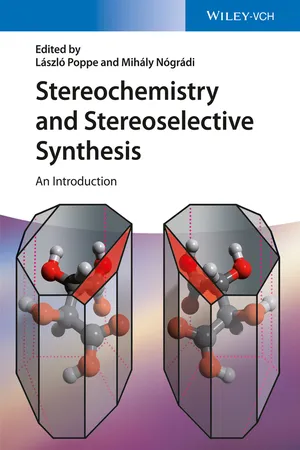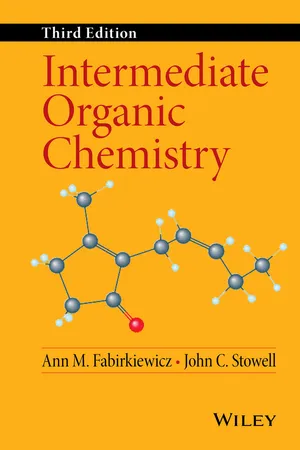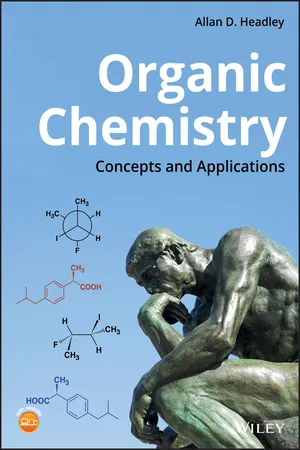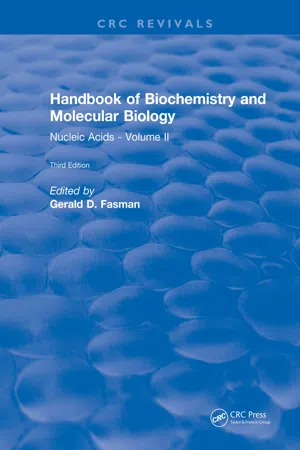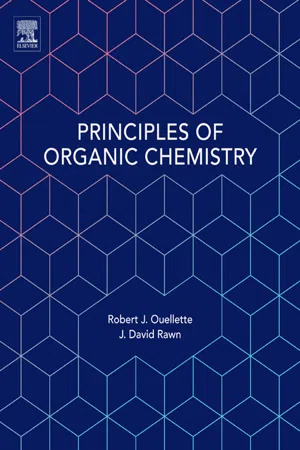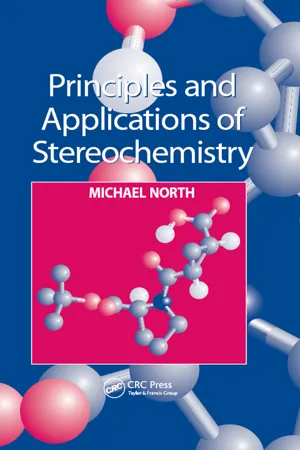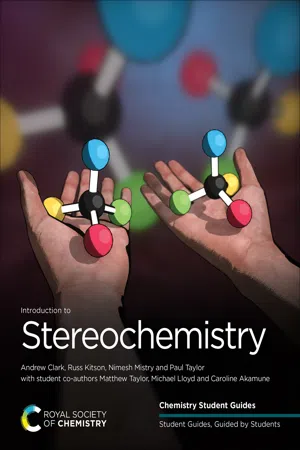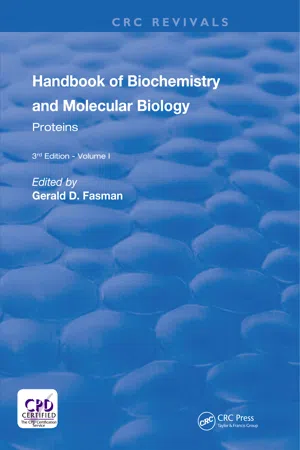Chemistry
Diastereomers
Diastereomers are a type of stereoisomer that have different spatial arrangements of atoms and are not mirror images of each other. They have different physical and chemical properties, such as melting points and solubilities. Diastereomers arise when a molecule has two or more stereocenters and can have multiple non-superimposable structures.
Written by Perlego with AI-assistance
Related key terms
Related key terms
1 of 4
Related key terms
1 of 3
10 Key excerpts on "Diastereomers"
- H. John Smith, Hywel Williams(Authors)
- 2005(Publication Date)
- CRC Press(Publisher)
Biological environments at a molecular level are highly chiral being composed of chiral biopolymers, e.g. proteins, glycolipids and polynucleotides, from the chiral building blocks of L-amino acids and the D-carbohydrates. As nature has made a preference in terms of its stereochemistry it is not surprising that enzymes and receptor systems show a stereochemical preference for one of a pair of stereoisomers. The interaction of a drug with a receptor, or enzyme active site, involves interaction between the functionalities of the drug molecule and complementary sites or groups on the receptor. Such interactions may have considerable steric constraints in terms of interatomic distance and steric bulk between such functionalities. In the case of stereoisomers the three dimensional spatial arrangement of the functionalities is of considerable significance.Enantioselectivity in drug action should not be surprising as many of the natural ligands are themselves chiral, e.g. neurotransmitters, autocoids, hormones, endogenous opioids etc. Indeed Lehmann has stated that “the stereoselectivity displayed by pharmacological systems constitutes the best evidence that receptors exist and that they incorporate concrete molecular entities as integral components of their active sites”.4.2 DEFINITIONS AND NOMENCLATURE
Stereochemistry is concerned with the three dimensional spatial arrangement of the atoms within a molecule. The prefix stereo originating from the Greek stereos meaning solid or volume. Stereoisomers are compounds which differ only in the three-dimensional arrangement of their constituent atoms in space and such isomers may be divided into two groups namely enantiomers and diastereoisomers. Enantiomers are pairs of compounds which are non-superimposable mirror images of one another and in terms of physicochemical properties, differ only in their ability to rotate the plane of plane polarised light which is equal in magnitude but opposite in direction. Such isomers are said to be chiral (from the Greek chiros meaning handed) and are variously referred to as optical isomers or enantiomorphs (Greek enantios opposite, morph- eBook - ePub
Stereochemistry and Stereoselective Synthesis
An Introduction
- Mihály Nógrádi, László Poppe, József Nagy, Gábor Hornyánszky, Zoltán Boros(Authors)
- 2016(Publication Date)
- Wiley-VCH(Publisher)
14Enantiomer: one among those nonsuperposable stereoisomers that are related as mirror images (enantiomers thus form pairs of mirror images). Enantiomers must be chiral. Scalar physical properties of enantiomers are identical; they only differ in vectorial physical properties, such as optical rotation. Their chemical behavior toward achiral agents is identical, while it may differ toward chiral agents [2–4].[This definition is in accord with IUPAC recommendation [2–4] on stereochemistry stating that enantiomers are pairs of molecular entities, which are not superposable and are related as mirror images.]15Possible forms of isomerism.Figure 2.6Conformation/configuration and isomeric relationships are illustrated by the isomers of cyclohexane (C6 H12 ) (Figure 2.7 ). It follows from the definitions and examples in Figure 2.7 that it depends on the type of isomerism under which conditions components of a mixture of isomers can be separated. Constitutional isomers and Diastereomers are differing in most of their chemical and physical properties, while enantiomers can only be differentiated by direction-dependent (vectorial) properties and exhibit different chemical reactivities only toward chiral partners. Examples in Figure 2.7 well illustrate the necessity of giving exact definitions and justify taking into consideration the criterion of isolability.Conformation, configuration, and various types of isomerism. The molecules shown all have the same molecular formula (C6 H12 ). Molecules placed into a common box are either identical (≡) or exist as a set of conformations capable to interconversion ( ). (c.i.: constitutional isomers; D: Diastereomers; and E: enantiomers).Figure 2.7By the example of cyclohexane shown in Figure 2.7 , it can be seen that its different conformational states cannot be isolated and are not separable molecular entities. Here, the imprecision of the IUPAC definition of conformation becomes apparent since the three states differ not only by rotation around single bonds. In the chair and the half-chair conformations, C–C–C bond angles are also different. The two states of methylcyclopentane shown are related as mirror images, but these are superposable and therefore achiral - eBook - ePub
- Ann M. Fabirkiewicz, John C. Stowell(Authors)
- 2015(Publication Date)
- Wiley(Publisher)
Figure 3.5 .Fischer projections of threo and erythro stereoisomers.Figure 3.5Chirality is a property of the whole molecule, as concluded by Pasteur even before the structural theory was established, and does not require the presence of a stereogenic atom. Molecules with a twist along an axis such as allenes (3.4), spiro compounds (3.5), and exocyclic double-bonded compounds (3.6) can be chiral. Crowding of groups in a molecule may restrict rotation about single bonds or prevent planarity, again generating a twist, giving conformational enantiomerism (3.7, 3.8).Finally, some molecules having a planar portion with one face distinguished from the other and lacking a plane of symmetry are chiral. Examples include paracyclophane (3.9) and trans-cyclooctene (3.10) [5].3.3 PROPERTY DIFFERENCES AMONG STEREOISOMERS
Thus far we have considered structures. Structural differences should be manifest in measurable property differences in actual substances.Diastereomers have different shapes, and the different manner in which each assembles with its own kind in the liquid or solid state will lead to different physical properties such as density, refractive index, melting point, and boiling point. In the gaseous state, shape is of little consequence because of the lack of assembly. For example, in the Victor Meyer method for determining molecular weight, measurements are done in the gaseous state, in which density depends largely on molecular weight. Diastereomers will also have dipolar differences, which will influence interaction with radiation, leading to different spectroscopic properties.The difference between enantiomers is very subtle. A homogeneous sample of a pure enantiomer will have properties dependent on the intermolecular attractions in the sample, and the mirror image will be no different in that regard. Thus the melting point, boiling point, refractive index, density, and spectra of each will be identical. Enantiomers will interact identically with achiral materials, but if each is allowed to interact with one enantiomer of a chiral material, the combinations will be diastereomeric, and therefore different. That chiral material can be a solvent, adsorbant, complexing agent, or reactant. A left hand will fit well in a left glove but not in a right glove. The left hand–left glove combination is diastereomeric with the left hand–right glove combination and thus has different properties. - eBook - ePub
Organic Chemistry
Concepts and Applications
- Allan D. Headley(Author)
- 2019(Publication Date)
- Wiley(Publisher)
Figure 5.2 .The molecules shown in Figure 5.2 differ from each other only in the spatial arrangements of the four different groups around the central carbon. This central carbon of compounds that have four different groups is known as a stereogenic carbon. Thus, a stereogenic carbon is a carbon that is bonded to four different groups. An examination of a slightly different molecule, which has the same two atoms or groups bonded to a carbon and two different atoms or groups, gives a totally different outcome, as shown in the molecules in Figure 5.3 .L ‐Alanine and D ‐alanine are different molecules; they are mirror images of each other and are not superimposable on each other.Figure 5.1Nonsuperimposable mirror images, also known as enantiomers.Figure 5.2Superimposable mirror images, or same molecules.Figure 5.3An example of a symmetrical molecule, which is not a stereogenic molecule.Figure 5.4Even though these compounds are mirror images of each other, they are superimposable on each other and hence they are not enantiomers, but instead they are the same molecules. Note that for these molecules there is a plane of reflection through the carbon, chlorine, and fluorine atoms, as shown in Figure 5.4 . That is, the two hydrogen atoms reflect across that plane. Such molecules are referred to as symmetric molecules or have a plane of symmetry. Such molecules are achiral or not stereogenic.5.2.1 Determination of Enantiomerism
The use of an imaginary mirror to assist in the determination of enantiomerism is a very tedious exercise. Some simple observations of the molecules in both examples given above can be made to decide if molecules are stereogenic or not. Molecules that are asymmetric or molecules that do not have a plane of symmetry (as the molecules shown in Figure 5.2 ) are stereogenic and will exhibit enantiomerism. If a molecule has a carbon atom that has four different groups bonded to that carbon, then that molecule is stereogenic. These simple observations will assist in a quick determination of enantiomerism in molecules. Figure 5.5 - eBook - ePub
Handbook of Biochemistry
Section B Nucleic Acids, Volume II
- Gerald D Fasman(Author)
- 2019(Publication Date)
- CRC Press(Publisher)
E-5.6. Stereoisomers that are not enantiomeric are termed diastereoisomers.Hence: diastereoisomeric (adjectival)diastereoisomerism (phenomenological)Note: Diastereoisomers may be chiral or achiral.Examples:E-5.7. A compound whose individual molecules contain equal numbers of enantiomeric groups, identically linked, but no other chiral group, is termed a meso compound.Example:E-5.8. An atom is termed pseudoasymmetric when bonded tetrahedrally to one pair of enantiomeric groups (+)-a and (−)-a and also to two atoms or groups b and c that are different from group a, different from each other, and not enantiomeric with each other.Examples:Notes: (1) The orientation, in space, of the atoms around a pseudoasymmetric atoms is not reversed on reflection; for a chiral atom (see Note to Rule E-5.3) this orientation is always reversed.(2) Molecules containing pseudoasymmetric atoms may be achiral or chiral. If ligands b and c are both achiral, the molecule is achiral as in the first example to this Rule. If either or both of the nonenantiomeric ligands b and c are chiral, the molecule is chiral, as in the second example to this Rule, that is the molecule is not identical with its mirror image. A molecule (i) is also chiral if b and c are enantiomeric, that is, if the molecule can be symbolized as (ii), but then, by definition, it does not contain a pseudoasymmetric atom.(3) Compounds differing at a pseudoasymmetric atom belong to the larger class of diastereoisomers.(4) In example (A), interchange of H and OH on C* gives a different achiral compound, which is an achiral diastereoisomer of (A) (see Rule E-5.6). In example (B), diastereoisomers are produced by inversion at C* or ◊ C, giving in all four diastereoisomers, all chiral because of the –CH(CH3 )CH2 CH3 group.E-5.9. Names of chiral compounds whose absolute configuration is known are differentiated by prefixes R, S, - Ahindra Nag(Author)
- 2018(Publication Date)
- CRC Press(Publisher)
1 Basic Stereochemical Approaches to Natural Products and Drugs Ahindra NagCONTENTS 1.1Basic Concept of Chirality 1.2Meso Compounds 1.3Tautomerism and Valance Tautomerism 1.4Conformation 1.5Fischer Projection and Absolute Configuration 1.6Chiral Resolution 1.6.1Crystal Picking 1.6.2Chemical Separation 1.6.3Biochemical Separation 1.6.4Chromatographic Separation 1.7Application of Enantiomers in Drugs and Natural Products Problems Answers References1.1Basic Concept of Chirality
An asymmetric carbon atom (known as the stereogenic center) is attached to four different groups1 termed a chiral (pronounced as kiral). The word chiral derives from the Greek word cheira meaning hand, which is closely related to optical activity. For a molecule to have chirality, it must not possess a plane, a center, or a fourfold alternating axis of symmetry. Molecules which are mirror images of each other are termed enantiomers (from the Greek entatios meaning opposite) and need chiral recognition to be separated. Enantiomers react1 , 2 , 3 , 4 , 5 , 6 at different rates with other chiral compounds and may have different solubilities in the presence of an optically active solvent. They may display different absorption spectra under circulatory polarized light. Enantiomers may have different optical rotations, which could be either (+), that is, dextrorotatory (clockwise), or (−), that is, levorotatory (anticlockwise), and can be determined by a polarimeter. The optical purity of a mixture of enantiomers is given by% Optical purity of sample = 100 ∗Specific rotation of sampleSpecific rotation of a pure enantiomerwhereSpecific rotationα D=α obs/c lαobs is the experimentally observed rotationc is the concentration in g/mLl is the path length of the cell used, expressed in dm (=10 cm)Enantiomeric excessis one of the indicators of the success of an asymmetric synthesis. The enantiomeric excess (eep7- eBook - ePub
- Robert J. Ouellette, J. David Rawn(Authors)
- 2015(Publication Date)
- Elsevier(Publisher)
n . The following example, 2,3,4-trihydroxybutanal, illustrates the general principle.C-2 and C-3 are chiral. They are nonequivalent because they are not bonded to identical groups. Therefore, the configurations at C-2 and at C-3 can be R or S. Without even drawing the structures, we predict that the four stereoisomers calculated from the 2n rule can be identified as (2R,3R), (2S,3S), (2R,3S), and (2S,3R). Figure 6.10 shows these configurations in Fischer projection formulas.Figure 6.10 Enantiomers and DiastereomersA molecule that contains two nonequivalent chiral centers, such as 2,3-4-trihydroxybutanal, can exist as four stereoisomers. They exist as two pairs of enantiomers. Stereoisomers that are not enantiomers are Diastereomers.The relationships between the stereoisomeric 2,3,4-trihydroxybutanals are established with mirror planes. Imagine a mirror placed between I and II. Structures I and II are nonsuperimposable mirror images; they are enantiomers. Structures III and IV are also nonsuperimposable mirror images. Like all enantiomers, they rotate plane-polarized light in equal and opposite directions.Structures I and III are stereoisomers, but they are not enantiomers.Stereoisomers that are not enantiomers are called Diastereomers.The pairs II and III, I and IV, and II and IV are Diastereomers. In contrast to enantiomers, which have the same chemical and physical properties, Diastereomers have different chemical and physical properties. For example, the enantiomers I and II both are liquids at room temperature and are very soluble in ethanol. The enantiomers III and IV both melt at 130°C and are only slightly soluble in ethanol.Nomenclature of Diastereomers
The name of a compound with two or more stereogenic centers must indicate the configuration of every center. The configuration of each stereogenic carbon atom is indicated by a number, which corresponds to its position in the carbon chain, and the letter R or S, separated by commas. Figure 6.10 - eBook - ePub
- Michael North(Author)
- 2017(Publication Date)
- Routledge(Publisher)
3 Enantiomers 3.1 Structure of enantiomersEnantiomers were introduced in Chapter 1 (section 1.5.1) as stereoisomers that are non-superimposable mirror images of one another. This definition of enantiomers based upon the non-superimposability of mirror images was originally proposed by Lord Kelvin and will serve as our definition in this and the next two chapters. An alternative but equivalent definition of enantiomers based upon the symmetry or lack of symmetry in a substance will be introduced in Chapter 6 . Any molecule (or other substance) that is not superimposable on its mirror image and so exists as a pair of enantiomers is said to be chiral and to exhibit chirality. Conversely, any molecule (or other substance) that is superimposable on its mirror image is achiral.By far the most common origin of chirality is when a tetrahedrally coordinated atom (usually carbon) is bound to four different substituents as shown in structure 3.1 . Indeed, whenever a molecule contains a single atom which is tetrahedrally bound to four different substituents, then two enantiomers are possible. It is, however, important that the four substituents a–d are different to one another, as if any two of them are identical then structure 3.1 would become superimposable on its mirror image and so achiral. The atom X in structure 3.1 is best referred to as a stereogenic centre or simply a stereocentre. A widely used, although somewhat misleading alternative name for a stereocentre is a chiral centre. This name is misleading since it implies that the chirality is localized around the atom X, whereas, in fact, chirality is a property of the molecule as whole that cannot be localized around one atom or a group of atoms. Hence the term ‘chiral centre’ will not be used in this book.The presence of a stereocentre is not a requirement for a molecule to exhibit chirality, it is simply the most common cause of chirality. Later in this chapter (section 3.8) other structural features (stereogenic elements) which can result in a molecule exhibiting chirality will be introduced. Whilst the presence of a single stereogenic element in a molecule will always cause the molecule to be chiral, if more than one stereogenic element is present, then the molecule may or may not be chiral as will be discussed in Chapter 4 . Non-superimposability upon its mirror image rather than the presence of any structural feature is the most reliable method to determine whether or not a species is chiral, although an alternative method based on symmetry considerations will be introduced in Chapter 6 - eBook - ePub
- Andrew Clark, Russ Kitson, Nimesh Mistry, Paul Taylor, Matthew Taylor, Michael Lloyd, Caroline Akamune(Authors)
- 2020(Publication Date)
- Royal Society of Chemistry(Publisher)
CHAPTERBy the End of This Chapter You Will: •Understand what makes molecules chiral or achiral.•Be able to assign the configuration of a stereogenic centre as R or S .•Understand the differences in the properties of enantiomers and diastereoisomers.•Understand the definition of pairs of enantiomers, pairs of diastereoisomers, racemates (racemic mixtures) and meso -compounds.•Understand how we measure the optical rotation of compounds.What You Will Get from This Chapter
In this chapter we will look initially at simple molecules containing one stereogenic centre, how we name these molecules and how we define the arrangement of the groups in 3-dimensions. We will then take a similar approach considering slightly more complicated examples with two or more stereogenic centres.Passage contains an image
Stereogenic Centres, Enantiomers and Diastereoisomers
We have a single top tip before you dive into Chapter 3. Get yourself a molecular model kit and use it! Evidence suggests that you can't really grasp stereochemistry until you've built your own models, picked them up, turned them round and really seen the three dimensions we are studying. If a standard model kit isn't right for you, there are some good new virtual tools, but you need to be able to manipulate the molecules yourself to gain this new understanding. Oh, and a small mirror may come in handy!In Chapter 1, we saw that stereochemistry is extremely important, particularly because different arrangements of atoms or substituents in three dimensions can lead to a very different biological response, as in the example of thalidomide. It is therefore essential that we have systematic methods to name and define different types of stereoisomer. In this chapter, we will look initially at simple molecules containing one stereogenic centre - eBook - ePub
Handbook of Biochemistry
Section A Proteins, Volume I
- Gerald D Fasman(Author)
- 2018(Publication Date)
- CRC Press(Publisher)
E-5.5. When equal amounts of enantiomeric molecules are present together, the product is termed racemic, independently of whether it is crystalline, liquid, or gaseous. A homogeneous solid phase composed of equimolar amounts of enantiomeric molecules is termed a racemic compound. A mixture of equimolar amounts of enantiomeric molecules present as separate solid phases is termed a racemic mixture. Any homogeneous solid containing equimôlar amounts of enantiomeric molecules is termed a racemate.Examples: The mixture of two kinds of crystal (mirror-image forms) that separate below 28° from an aqueous solution containing equal amounts of dextrorotatory and levorotatory sodium ammonium tartrate is a racemic mixture.The symmetrical crystals that separate from such a solution above 28°, each containing equal amounts of the two salts, provide a racemic compound. E-5.6. Stereoisomers that are not enantiomeric are termed diastereoisomers.Hence: diastereoisomeric (adjectival)diastereoisomerism (phenomenological)Note: Diastereoisomers may be chiral or achiral. Examples:E-5.7. A compound whose individual molecules contain equal numbers of enantiomeric groups, identically linked, but no other chiral group, is termed a meso compound.Example:E-5.8. An atom is termed pseudoasymmetric when bonded tetrahedrally to one pair of enantiomeric groups (+)-a and (-)-a and also to two atoms or groups b and c that are different from group a, different from each other, and not enantiomeric with each other.Examples:Notes: (1) The orientation, in space, of the atoms around a pseudoasymmetric atoms is not reversed on reflection; for a chiral atom (see Note to Rule E-5.3) this orientation is always reversed.- Molecules containing pseudoasymmetric atoms may be achiral or chiral. If ligands b and c are both achiral, the molecule is achiral as in the first example to this Rule. If either or both of the nonenantiomeric ligands b and c are chiral, the molecule is chiral, as in the second example to this Rule, that is the molecule is not identical with its mirror image. A molecule (i) is also chiral if b and c are enantiomeric, that is, if the molecule can be symbolized as (ii), but then, by definition, it does not contain a pseudoasymmetric atom.
Index pages curate the most relevant extracts from our library of academic textbooks. They’ve been created using an in-house natural language model (NLM), each adding context and meaning to key research topics.
Explore more topic indexes
Explore more topic indexes
1 of 6
Explore more topic indexes
1 of 4

